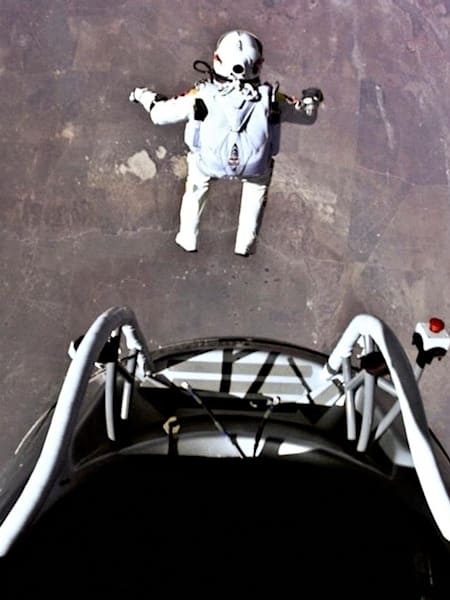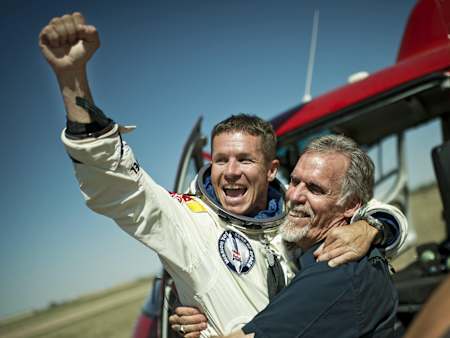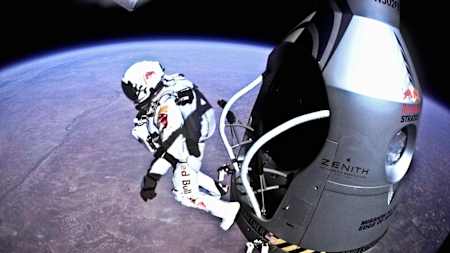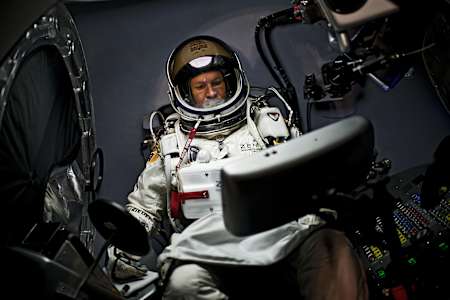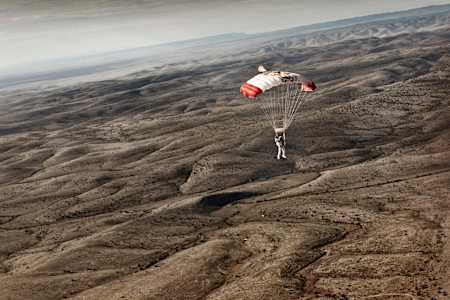
3 min
Mission Accomplished!
Highlights from Red Bull Stratos, Felix Baumgartner's record breaking jump from the edge of space.
But in that short time frame, not one, not two, but 8 world records were broken, making Red Bull Stratos the most ambitious skydive project ever attempted, with implications far beyond the excitement of his spectacular achievement. Far more than just an action stunt, Red Bull Stratos actively advanced the study of humans in flight – with incredible results.
Millions tuned in live on October 14, 2012 to watch Felix Baumgartner jump into legend. The entire world knew it had witnessed a land-mark event. For Baumgartner and Stratos Technical Directer Art Thompson, pictured above, more good news came later: on February 22, the world governing body for aeronautic records, the Fédération Aéronautique Internationale (FAI), confirmed that their stringent verification process was complete and Baumgartner did, as anticipated, break world records in three official categories – vertical speed, exit altitude, and vertical free-fall, plus five more records outside of FAI categorization. Here are the official FAI records: Maximum Vertical Speed (without drogue) 1,357.6kph (equivalent to 843.6mph / Mach 1.25)
Exit (Jump) Altitude 38,969.4 metres (equivalent to 127,852.4 feet) above mean sea level
Vertical Distance of Freefall (without drogue) 36,402.6 metres (equivalent to 119,431.1 feet) Here are Red Bull Stratos world records achieved that fall outside FAI official categorization:
• First person to break the speed of sound in freefall, without the protection of or propulsion of a vehicle • Highest untethered altitude outside a vehicle • Largest balloon ever flown with a human aboard: 29.47 million cubic feet • Highest manned balloon ascent: 39,068.5 metres / 128,177.5 feet • Fastest overland speed of manned balloon: 135.7 miles per hour / 117.9 knots
While the general public may view the announcement as a formality, it wasn't without meaning to the Red Bull Stratos team, whose years of work paid off when Baumgartner safely touched down in the New Mexico desert. “We have been eagerly awaiting this announcement,” said Red Bull Stratos technical project director Art Thompson, from his office at Sage Cheshire Aerospace in Lancaster, California. “These accomplishments were truly a group effort, and my hat is off not only to Felix, but to the entire team whose determination and innovations made the flight possible. I’d also like to thank the FAI, the National Aeronautic Association of the United States and the United States Parachute Association for working with us throughout program development, so that we could document previously uncharted levels of achievement in accordance with their requirements.”
Baumgartner expressed his appreciation for the validity of the FIA's record-verification process. “The great thing about records is that they’re inspiring. I was inspired by Joe Kittinger’s records from 1960 -- while unofficial, they are renowned throughout the aerospace community, and the team and I used them as benchmarks in developing the Red Bull Stratos program. Now in turn, I am hearing that people are being inspired by my records to follow their dreams and achieve extraordinary things. That’s the best kind of progression."
Perhaps even more impressive are the numerous records that do not fall within the official categories outlined in the FAI rules. Most significant among them: Baumgartner was the first person to break the speed of sound without the protection or propulsion of a vehicle. Why is this so important? Simple – the proof that a human can safely break the speed of sound in freefall opens up new avenues in the search for ways to escape from high-altitude aircraft in emergency situations. Former NASA Flight Surgeon Jonathan Clark headed Baumgartner's medical team. As he told the Huffington Post, "It was Mach 1.24, which is really huge. I mean, that's a much higher level than we'd ever anticipated, so we learned a lot by going faster and higher." Data such as heart rate and blood pressure were collected by sensors placed on Baumgartner's body. The safe exit level for astronauts is currently limited at 6 miles above sea level, and for speeds under 230 mph, number that equate to approximately a quarter of the height and speed Baumgartner achieved. Technological advancements stemming from Red Bull Stratos may take those much higher.
While Baumgartner's jump will live on as legend simply because of incredible height, it's these other records that will have the most implications for future skydivers. It is said that humans only learn by failure. But thanks to Baumgartner, we have learnt by success rather than failure - and we have learned a lot.

